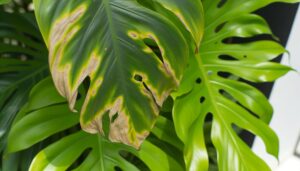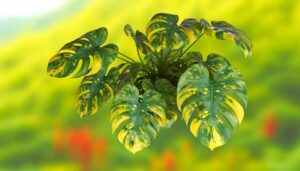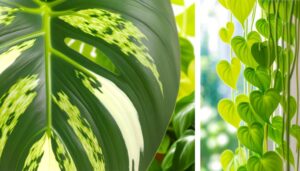Monstera Borsigiana Vs Deliciosa
Monstera deliciosa and Monstera borsigiana, both from the Araceae family, exhibit notable distinctions. Monstera deliciosa, native to southern Mexico and Panama, has larger, more broadly fenestrated leaves, reaching up to three feet in diameter.
In contrast, Monstera borsigiana's leaves are smaller and uniformly fenestrated. Growth-wise, M.
borsigiana exhibits faster growth and better climbing capabilities due to longer internodes, while M. deliciosa grows slower with shorter internodes.
Moreover, M. deliciosa produces thicker aerial roots for structural support whereas M.
borsigiana's roots are thinner but more abundant. To explore further nuances, stick around to uncover more insights.
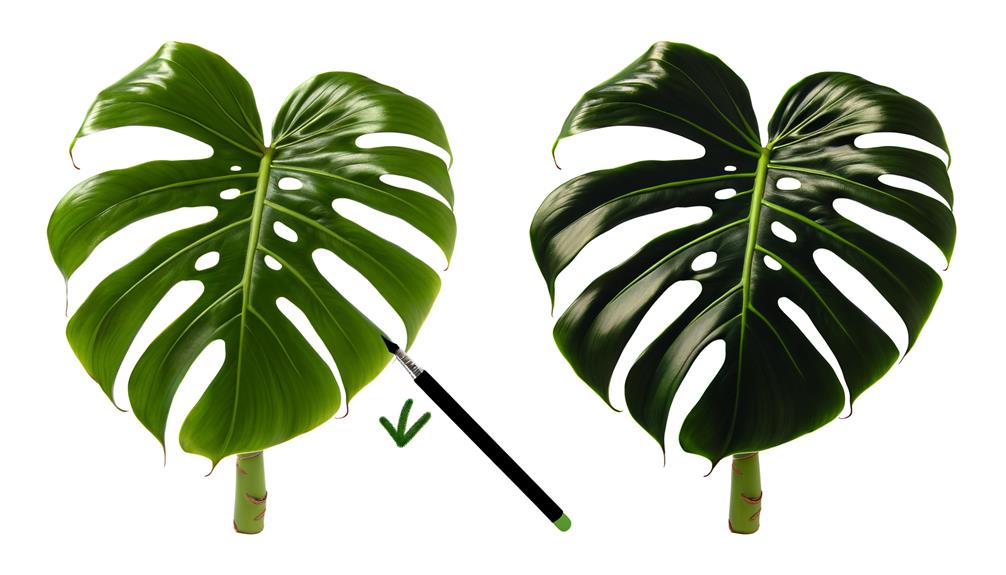
Key Takeaways
- Monstera deliciosa has larger, broader leaves with pronounced fenestrations compared to Monstera borsigiana's smaller, uniformly fenestrated leaves.
- Monstera borsigiana grows faster and has longer internodes than the slower-growing Monstera deliciosa with shorter internodes.
- Monstera deliciosa's aerial roots are thicker and provide more support, while Monstera borsigiana's roots are thinner and enhance adherence.
- Monstera borsigiana is more adept at climbing, whereas Monstera deliciosa tends to spread horizontally without support.
- Both require filtered sunlight and well-draining soil, but Monstera deliciosa may be more prone to pest infestations.
Origin and Classification

Monstera borsigiana and Monstera deliciosa, both members of the Araceae family, have distinct origins and classifications that are essential for understanding their botanical differences.
Monstera deliciosa, native to the tropical rainforests of southern Mexico and Panama, is classified as a hemiepiphyte, beginning its life on the forest floor and later climbing trees.
In contrast, Monstera borsigiana is considered a variety or subspecies of Monstera deliciosa, often distinguished by its more rapid growth and slightly different morphological traits.
Taxonomically, both species belong to the Monsteroideae subfamily, but Monstera borsigiana is frequently referred to as a variant due to its genetic and phenotypic similarities with Monstera deliciosa.
Understanding these classifications aids in accurately identifying and cultivating each species.
Leaf Shape and Size
Examining the leaf shape and size, one can observe notable differences that further distinguish Monstera borsigiana from Monstera deliciosa, despite their shared taxonomic background.
Monstera deliciosa typically exhibits larger, broader leaves with pronounced fenestrations and splits, often reaching up to three feet in diameter. These leaves display a more irregular, wavy pattern along the edges.
In contrast, Monstera borsigiana showcases relatively smaller leaves, usually around one to two feet in diameter, with more uniform and symmetrical fenestrations. Additionally, the petioles of M. borsigiana are slenderer and less robust compared to those of M. deliciosa.
These morphological distinctions are critical for botanists and horticulturists aiming to correctly identify and cultivate these popular aroids.
Growth Patterns

The growth patterns of Monstera borsigiana and Monstera deliciosa exhibit distinct differences, particularly in their vining behavior and rate of development. Monstera borsigiana is characterized by a faster growth rate, often producing longer internodes, which contributes to its more pronounced vining nature.
Conversely, Monstera deliciosa grows at a comparatively slower pace, resulting in shorter internodes and a more compact growth habit. This distinction influences their climbing tendencies; borsigiana is more adept at climbing structures, while deliciosa tends to spread more horizontally if not supported.
Additionally, borsigiana often exhibits more prolific aerial root production, facilitating its climbing capabilities. These variances in growth patterns are essential for horticulturists and plant enthusiasts when selecting the appropriate Monstera for their specific spatial and aesthetic requirements.
Stem Structure
Examining the stem structure of Monstera Borsigiana and Monstera Deliciosa reveals significant differences in their node and internode characteristics, as well as their aerial root formation.
Monstera Borsigiana typically exhibits longer internodes and fewer roots emerging from each node compared to Monstera Deliciosa, which has shorter internodes and more prolific aerial root development.
These distinctions play an essential role in their respective climbing abilities and overall growth habits.
Node and Internode Differences
A critical distinction between Monstera borsigiana and Monstera deliciosa lies in the morphology of their nodes and internodes, where borsigiana exhibits comparatively shorter internodes and a more compact node arrangement. This structural difference impacts the overall growth pattern and spacing of the plant. Monstera deliciosa typically has longer internodes, resulting in a more spread-out appearance, while Monstera borsigiana's compact internodes contribute to a more bushy and dense growth form. This characteristic is crucial for botanists and horticulturists in distinguishing between these two species, especially when juvenile plants are concerned.
| Feature | Monstera borsigiana | Monstera deliciosa |
|---|---|---|
| Internode Length | Short | Long |
| Node Arrangement | Compact | Spread-out |
| Growth Pattern | Bushy, Dense | More Open |
| Juvenile Identification | Easier | More Challenging |
| Morphological Impact | Compact Structure | Elongated Structure |
Aerial Root Development
Distinctive differences in aerial root development between Monstera borsigiana and Monstera deliciosa provide further insight into their unique stem structures and growth habits.
Monstera deliciosa exhibits more robust and thicker aerial roots, which are essential for anchoring the plant as it climbs and for absorbing moisture and nutrients from the air. In contrast, Monstera borsigiana produces comparatively thinner and less developed aerial roots, reflecting its tendency to grow more compactly.
The stem structure of Monstera deliciosa is generally sturdier, supporting its larger aerial roots and expansive growth. Meanwhile, Monstera borsigiana's slimmer stems correlate with its less vigorous aerial root system, suggesting adaptations to different environmental niches.
Understanding these differences aids in optimizing care and cultivation practices for each species.
Aerial Roots
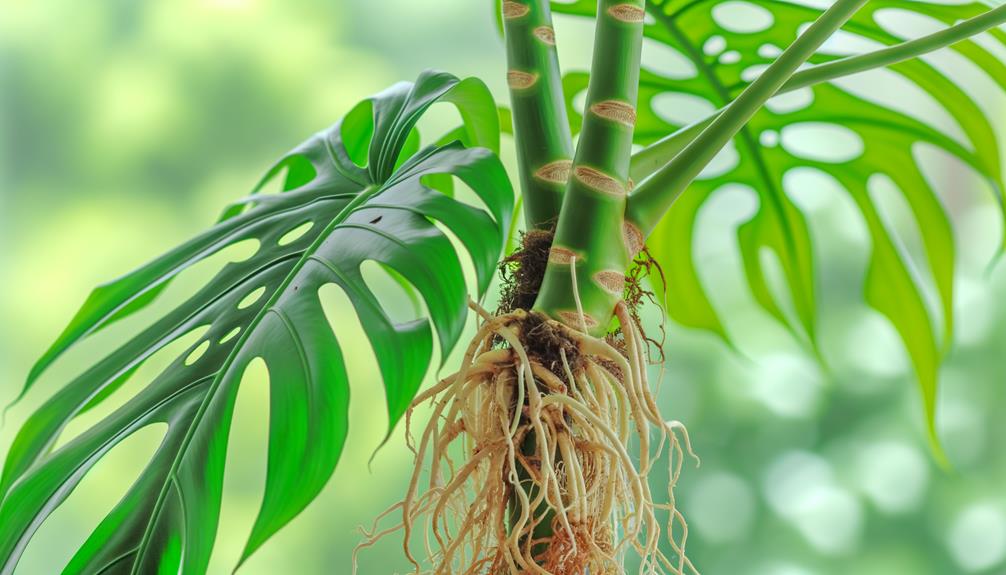
While both Monstera Borsigiana and Monstera Deliciosa develop aerial roots, the morphology and growth patterns of these structures exhibit notable differences that influence their climbing and support mechanisms. Monstera Deliciosa typically produces thicker, more robust aerial roots, which provide substantial support for the plant as it climbs. In contrast, Monstera Borsigiana's aerial roots are generally thinner and more numerous, enhancing its ability to adhere to various surfaces.
| Attribute | Monstera Borsigiana | Monstera Deliciosa |
|---|---|---|
| Root Thickness | Thinner | Thicker |
| Root Quantity | More numerous | Less numerous |
| Support Mechanism | Enhanced adherence to surfaces | Provides substantial structural support |
These distinctions contribute significantly to the differing environmental adaptations and growth patterns observed in these closely related species.
Care Requirements
Understanding the care requirements of Monstera Borsigiana and Monstera Deliciosa necessitates a thorough examination of their distinct growing conditions, which are influenced by their unique aerial root structures.
Monstera Borsigiana typically requires less frequent watering, preferring a well-draining soil medium to prevent root rot. Conversely, Monstera Deliciosa benefits from a slightly more moisture-retentive substrate due to its larger root system. Both species thrive in high-humidity environments, although Deliciosa exhibits a greater tolerance for occasional fluctuations.
Nutrient requirements also differ subtly; Deliciosa demands a more robust fertilization regimen to support its larger foliage and growth rate. In contrast, Borsigiana, being relatively smaller, requires less frequent feeding. These distinctions underscore the importance of tailored care protocols.
Light Preferences
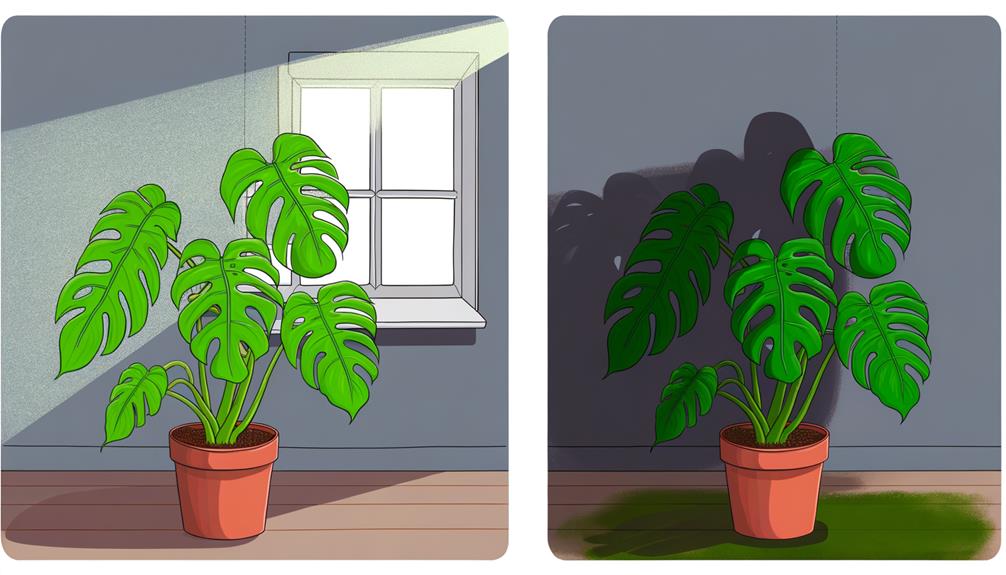
Both Monstera Borsigiana and Monstera Deliciosa exhibit a preference for bright, indirect light, although Deliciosa can better tolerate lower light conditions due to its larger leaf surface area, which enhances photosynthetic efficiency.
Monstera Borsigiana, with its more compact growth pattern, thrives in consistent bright light to maintain peak health and foliage development. Conversely, Monstera Deliciosa's expansive leaves allow it to capture and utilize light more effectively, enduring dimmer environments more robustly.
Inadequate light for either species may result in etiolation, where the plant exhibits elongated stems and sparse leaves. As a result, positioning near a north or east-facing window is ideal, ensuring filtered sunlight without direct exposure, which can cause leaf burn and impede overall growth.
Watering Needs
When analyzing the watering needs of Monstera Borsigiana and Monstera Deliciosa, it is essential to take into account frequency and amount, soil moisture levels, and seasonal adjustments.
Both species require consistent yet moderate watering, but Borsigiana tends to be slightly less tolerant of overwatering compared to Deliciosa. Understanding these distinctions is vital for optimizing growth and preventing root rot, especially when adjusting for varying seasonal moisture requirements.
Frequency and Amount
The watering needs of Monstera Borsigiana and Monstera Deliciosa exhibit notable differences in frequency and quantity, necessitating careful monitoring to promote growth and health for each species. Monstera Borsigiana typically requires more frequent watering due to its smaller size and faster growth rate. In contrast, Monstera Deliciosa, with its larger, thicker leaves, demands less frequent but more substantial watering sessions. These variations underscore the importance for a tailored watering regimen to prevent root rot and dehydration.
| Species | Watering Frequency | Watering Amount |
|---|---|---|
| Monstera Borsigiana | Every 5-7 days | Moderate |
| Monstera Deliciosa | Every 7-10 days | Generous |
Understanding these distinctions is essential for achieving best plant health.
Soil Moisture Levels
Monitoring soil moisture levels is crucial for determining the precise watering needs of Monstera Borsigiana and Monstera Deliciosa, as it directly influences root health and overall plant health.
Both species require well-draining soil to prevent waterlogging, which can lead to root rot. Monstera Borsigiana typically prefers slightly drier conditions compared to Monstera Deliciosa, which can tolerate slightly higher moisture levels.
Employing a soil moisture meter can provide accurate readings, ensuring ideal hydration. The perfect moisture level for Monstera Borsigiana is within the 4-6 range, whereas Monstera Deliciosa thrives at a level of 5-7.
Regularly inspecting soil moisture before watering can prevent over- or under-watering, promoting strong growth and minimizing stress on the plants.
Seasonal Adjustments
Seasonal changes necessitate adjustments in watering routines for Monstera Borsigiana and Monstera Deliciosa to accommodate their varying physiological needs throughout the year. During the warm months, both species show increased metabolic activity, requiring more hydration. Conversely, in cooler periods, their growth rate decreases, reducing water needs.
However, specific distinctions exist between the two. Monstera Borsigiana shows quicker growth during spring and summer, needing more frequent watering. On the other hand, Monstera Deliciosa tends to retain moisture longer due to its strong root system, hence requiring less frequent watering even in summer. Monitoring ambient humidity is crucial as higher humidity demands less frequent watering. Soil moisture consistency is also key to ensure the soil is not waterlogged, preventing root rot.
This comparative analysis guarantees effective hydration strategies tailored to each species' seasonal needs.
Common Pests
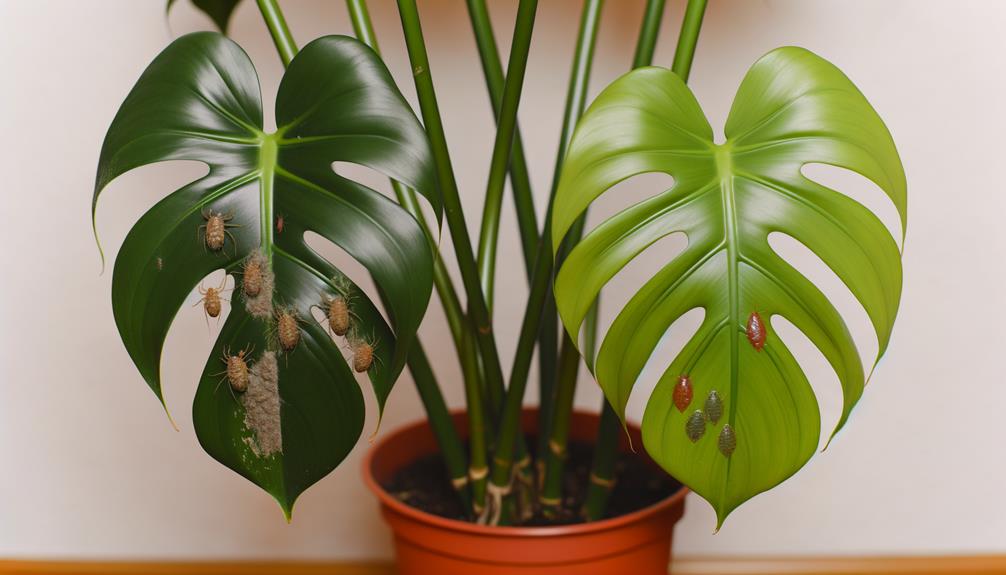
Common pests affecting Monstera Borsigiana and Monstera Deliciosa include spider mites, mealybugs, and scale insects, which can greatly impact plant health and growth.
Spider mites (Tetranychidae) are microscopic arachnids that cause stippling and yellowing of leaves due to their sap-sucking behavior.
Mealybugs (Pseudococcidae) secrete honeydew, leading to sooty mold and plant stunting.
Scale insects (Coccoidea) produce a waxy coating that shields them while they extract nutrients, causing leaf yellowing and drop.
Although both Monstera species are susceptible to these pests, Monstera Deliciosa's larger leaf surface area may make it more prone to infestations.
Effective management strategies include regular inspection, biological control agents like ladybugs, and appropriate use of insecticidal soaps or horticultural oils.
Propagation Methods
When examining the propagation methods of Monstera Borsigiana and Monstera Deliciosa, two primary techniques are often utilized: the stem cuttings technique and the air layering approach.
The stem cuttings method involves excising a segment of the plant stem with at least one node, which is then rooted in water or soil to encourage new growth.
In contrast, the air layering approach entails inducing root development on a still-attached segment of the stem by wounding it, applying a rooting hormone, and wrapping it in moist sphagnum moss until roots form, before detaching and potting.
Stem Cuttings Technique
Utilizing stem cuttings for propagation, a widely recognized horticultural technique, offers a comparative advantage in the efficient reproduction of both Monstera borsigiana and Monstera deliciosa, allowing for the detailed study of growth patterns and genetic consistency between these species. This method involves excising a section of the stem, typically containing at least one node and aerial root, and placing it in a suitable growth medium to initiate root development.
Key benefits of stem cuttings include:
- Consistency in genetic traits
- Faster establishment compared to seed propagation
- Enhanced ability to observe phenotypic variations
- Cost-effectiveness and minimal resource requirement
Air Layering Approach
Employing the air layering approach, a sophisticated propagation method, entails inducing root development on a stem while it remains attached to the parent plant, thereby offering a controlled environment to compare the root formation dynamics of Monstera borsigiana and Monstera deliciosa.
This method involves wounding the stem and applying rooting hormone, followed by enclosing the wound with moist sphagnum moss and securing it with plastic wrap.
In Monstera borsigiana, root development tends to be more rapid due to its generally faster growth rate. Conversely, Monstera deliciosa, known for its larger, more robust structure, may exhibit slower but more substantial root formation.
These differences underscore the distinct physiological characteristics inherent to each species, providing valuable insights for horticulturists and plant enthusiasts.
Conclusion
To conclude, a comparative study of Monstera borsigiana and Monstera deliciosa unveils distinct differences in leaf morphology, growth patterns, and care requirements.
The intricate variances in stem structure and aerial root development further highlight the unique characteristics of each species.
Understanding these botanical distinctions not only enhances horticultural practices but also deepens the appreciation for the diversity within the Monstera genus.
Consequently, the nuanced differences between borsigiana and deliciosa are as evident as the clarity of a well-polished gem.


